This post is also available in: Español
This is a recipe for dulce de chilacayote cristalizado or crystalized chilcacayote candy. This traditional Guatemalan candy is made with chilacayote squash, also knows as fig leaf gourd. If you’ve ever had crystalized chilacayote you know that this is a truly unique sweet. The roots and cooking method for this traditional Guatemalan recipe can be traced back to the ancient Maya civilization.
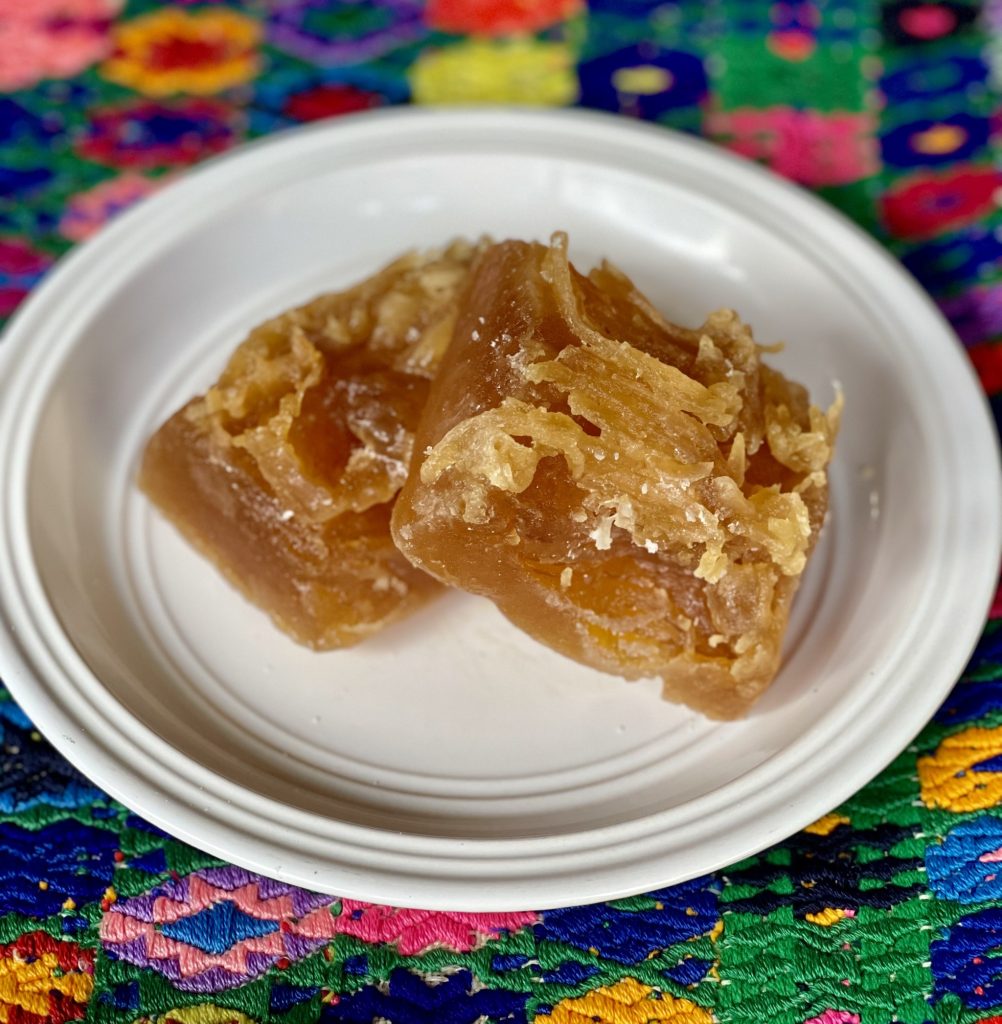
This recipe for crystalized chilacayote or dulce de chilacayote requires only three ingredients: chilacayote, sugar and cinnamon sticks. The process for the crystalization of the chilacayote candy takes about five or six days as the squash needs a lot of time to rest in the syrup and dry. However the process for this delicious Guatemalan dessert is very simple and easy.
Crystalized chilacayote candy is quite different from the chilacayote en dulce or the chilacayote en miel, which consists in the squash cooked and served with sweet syrup. You can get the recipe for chilacayote en miel here. The chilacayote candy, on the other hand is dry candied or crystalized chilacayote that has a slight sugary crunch on the outside and is soft, sweet and soaked in a caramelized honey on the inside. It has a unique and delicious taste and texture, unlike anything else I’ve ever tasted.
Chilacayote: A Pupular Traditional Guatemalan Candy
Growing up in Guatemala I developed a deep love and appreciation for traditional Guatemalan candy. We would often visit Antigua Guatemala during the weekends and what I enjoyed the most about going to this beautiful colonial city was visiting the Doña María Gordillo candy store. We were allowed to pick four types of candy and the chilacayote was always one of my favorites.
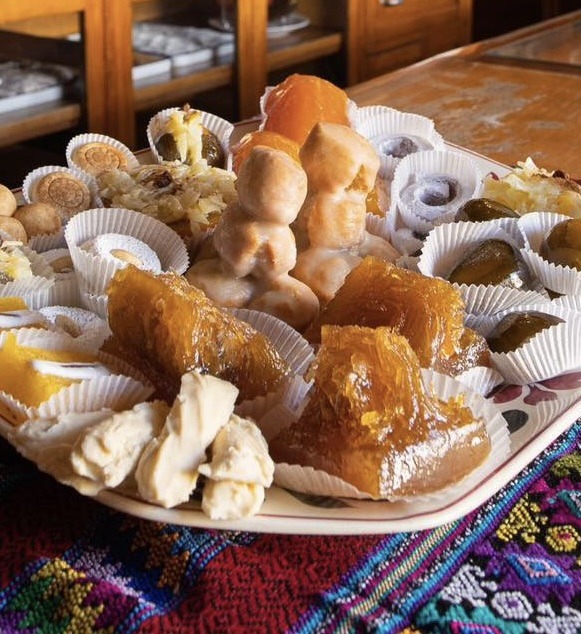
Chilacayote candy is one of the most beloved Guatemalan candies and is not only found in candy stores like Doña María Gordillo and El Sombreron but it’s also popular in fairs and fiestas patronales and often found for sale in markets and outside churches. If you’re looking for a traditional Guatemalan food that is both delicious, unique and filled with history and tradition the chilacayote candy is a great option!
Make sure to check out my article about traditional Guatemalan candy where I share the most popular dulces típicos (traditional sweets) as well as their history.
What is Chilacayote?
Chilacayote (cucurbita ficifolia), also known as fig leaf gourd in some places, is a type of squash that grows in Guatemala and other parts of Central and South America. It’s quite large and has a green, hard outer shell with a white, fibrous interior. Chilacayote is a sweet and juicy and has a texture similar to melon and a mild, sweet taste. When it’s raw, it might not look very appetizing, but when cooked, it transforms into something sweet and delicious. This squash is not only tasty but also packed with nutrients, making it a healthy addition to various dishes.
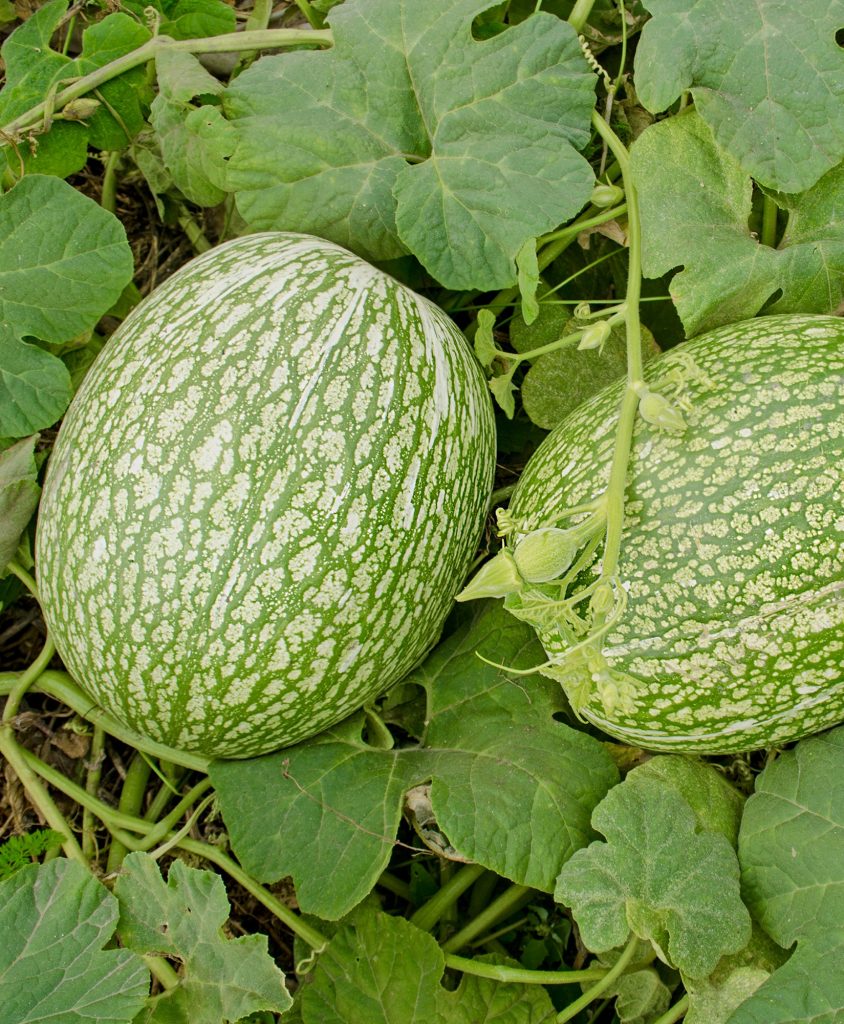
Chilacayote, also known as fig-leaf gourd, is a versatile and nutritious food. It’s packed with vitamins and minerals like Vitamin C, which helps our immune system, and Vitamin A, important for our eyes. Plus, it’s high in fiber, which keeps our digestion healthy and helps us feel full longer, which can be helpful for managing weight.
Nutritional and Medicinal Benefits of Chilacayote
Not only is chilacayote good for our bodies, but it’s also been used in traditional medicine for different reasons. Its fiber can help control blood sugar levels, which is useful for people with diabetes. It also acts as a diuretic, helping our bodies get rid of toxins and extra fluids. Some research even suggests it might be good for our heart, by lowering blood pressure and cholesterol levels. Plus, it has antioxidants that fight against harmful molecules in our bodies, possibly reducing the risk of certain diseases.
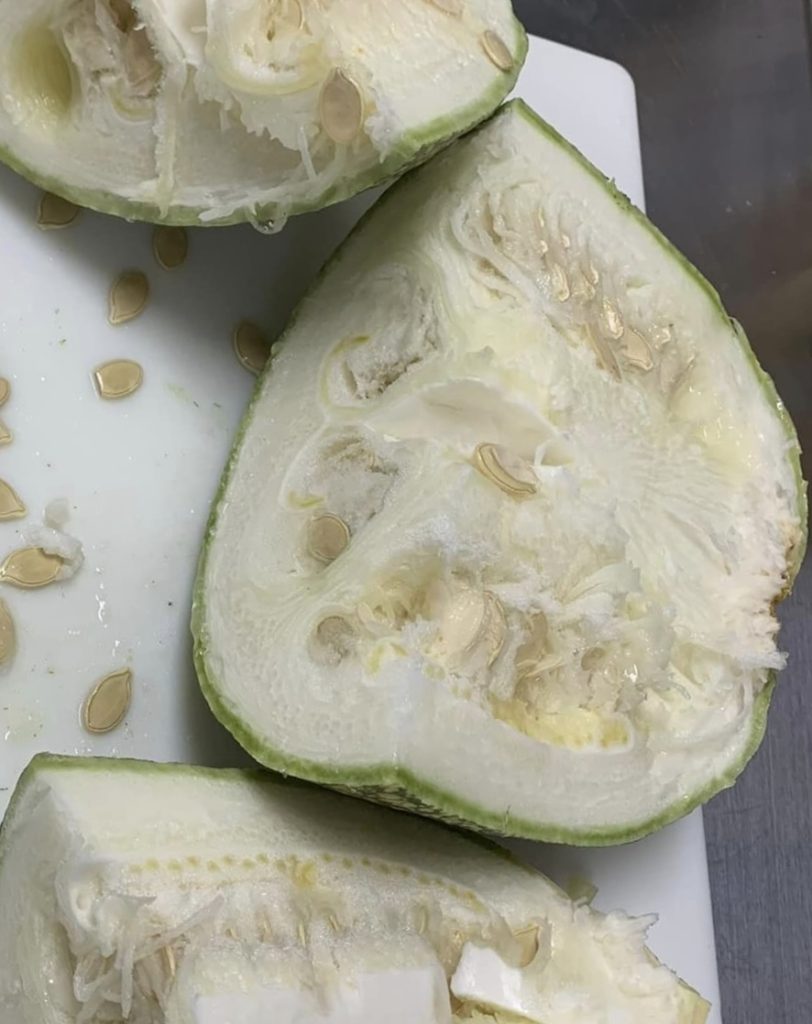
What is Chilacayote Used For?
Chilacayote is incredibly versatile and used in many different ways in Guatemalan cuisine. One of its most popular uses is in making a traditional sweet treat called “chilacayote en dulce” or “chilacayote en miel” (chilacayote in honey) where the squash is cooked in a syrup.

Chilacayote is also candied and crystalized to make “dulce de chilacayote” or candied chilacayote. It’s also used in savory dishes, often added to stews and soups to give them a slight sweetness and a boost of texture. In Guatemala, it is used in many sweet recipes, such as candies, preserves, tamales, and desserts. Beyond its use in cooking, chilacayote can be used as a natural sweetener and is sometimes even made into refresco de chilacayote, a refreshing drink popular during Semana Santa (Holy Week) and Cuaresma (Lent).
Origin and History of Chilacayote in Guatemala
The chilacayote squash has deep roots in Guatemala, with its cultivation and use dating back to ancient times, long before the arrival of Europeans. It was a staple in the diet of the Maya civilization, valued for its ability to be stored for long periods and its versatility as a food source. The indigenous peoples of Guatemala cultivated chilacayote along with other crops, utilizing it in their daily meals and traditional ceremonies.
Over time, Spanish influences introduced new ingredients and cooking methods, shaping the recipe we know today. Over the centuries, chilacayote has remained an important part of Guatemalan culture, symbolizing the rich agricultural heritage and the blending of indigenous and Spanish culinary traditions.
Using Nixtamalization to Make Crystalized Fruit
Crystalizing fruit through nixtamalization traditionally involves soaking the fruit in an alkaline solution made by adding slaked lime (food gradecalcium hydroxide) or wood ash to water, before it is cooked in sugar syrup to crystallize. The alkaline solution hardens the fruit allowing helping it keep it’s shape throughout the lengthy cooking process involved in it’s crystalisation and also helps preserve the fruit. This not only prolongs the fruit’s shelf life but also intensifies its taste.
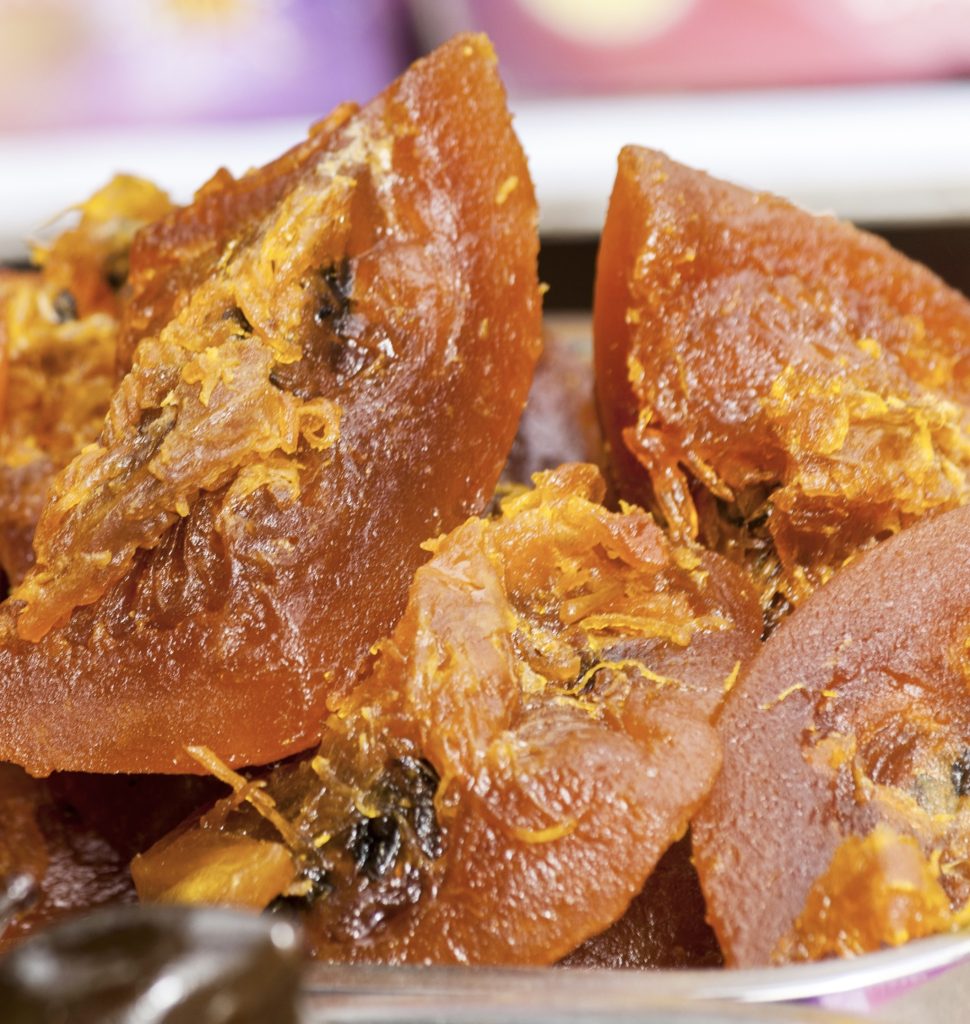
What is Nixtamalization
Nixtamalization is an ancient technique originally used to treat corn, which has interestingly found its way into the crystallization of fruit in places like Guatemala and Mexico.
The roots of nixtamalization stretch back over thousands of years to Mesoamerica, where indigenous peoples discovered that treating corn with an alkaline solution, often from wood ash, could remove its husk, boost its nutritional benefits, and make it safer for consumption.
This groundbreaking discovery was vital for the sustainability of ancient civilizations, providing a reliable food source that could be stored for extended periods. As time went on, the principles of nixtamalization were also applied to fruits, leading to the diverse and rich tradition of candied fruits found in Central American and Mexican cuisines today.
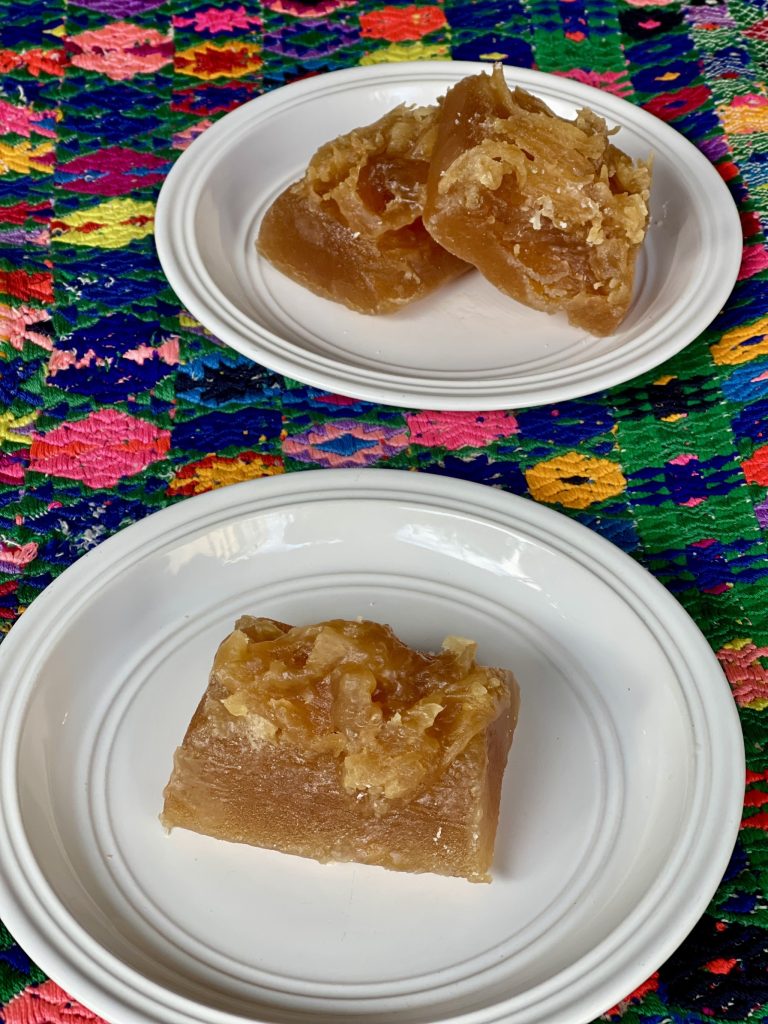
Crystalized Chilacayote Candy Recipe – Chilacayote Cristalizado
Ingredients:
- 1 small chilacayote squash
- 1 cup slaked lime (food grade calcium hydroxide)
- 5 liters of water (for the lime solution)
- 7 lbs + 1/ cup of sugar
- 14 liters of water for soaking, rinsing and cooking
- Cinnamon sticks, to taste
Note: if you need more water, consider that the ratio of lime to water should be ¼ cup of lime per liter of water.
Instructions:
-
Preparing the Chilacayote:
-
-
- Wash the chilacayote thoroughly and remove any dirt.
- Peel the chilacayote using a sharp knife.
- Cut the chilacayote into large cubes, about 3 inches by 3 inches.
-
-
Soaking the Chilacayote in Lime:
-
-
- Dissolve slaked lime in 5 liters of water in a large container.
- Submerge the chilacayote cubes in the lime solution and let them soak for 24 hours.
- Rinse the chilacayote pieces with plenty of water the next day to remove lime residue.
- Make small holes in each chilacayote piece using a fork or toothpick.
-
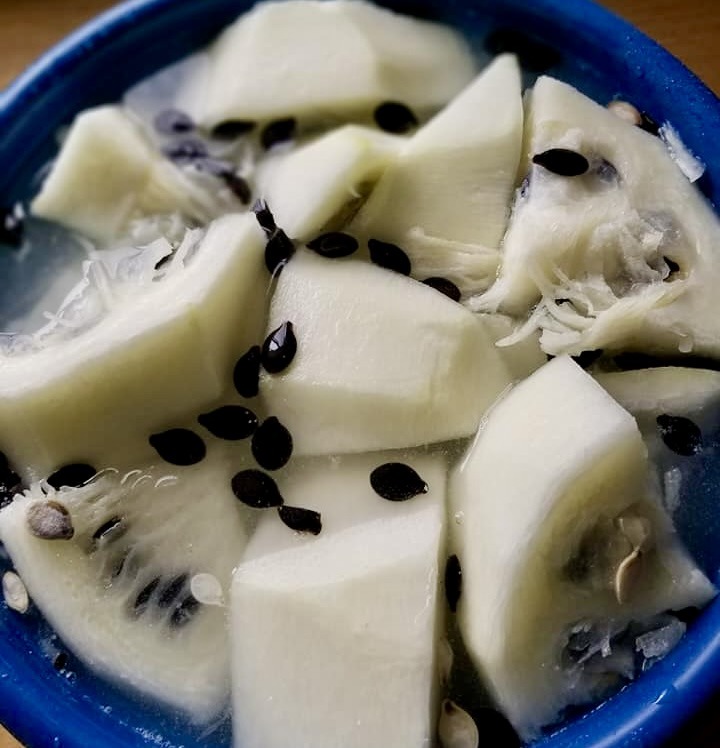
-
Preparing the Syrup:
-
-
- Boil about 2 liters of water in a large pot.
- Cook the chilacayote in boiling water for 5 minutes, then remove and discard the water.
- Rinse the chilacayote again under running water.
- In the same pot, combine 5 liters of water, 3 lbs of sugar, and cinnamon sticks.
- Bring to a boil and simmer for 30 minutes until the sugar dissolves.
- Add the chilacayote cubes to the syrup and simmer for 1 hour.
- Let it stand for 24 hours.
- Repeat this process for five days, each time adding 1 lb of sugar to the syrup and simmering the chilacayote for 1 hour.
-
-
Final Steps:
-
- On the fifth day, simmer the chilacayote in the syrup for about 3 hours until crystallized.
- Remove the chilacayote from the syrup and drain on a rack.
- Let them dry for at least 8 hours.
- Boil 1 liter of water, add ½ cup of sugar, and bring to a boil.
- Dip each chilacayote piece in the boiling sugar water for a few seconds, then place on a drying rack.
- Sprinkle each piece with powdered sugar using a strainer, ensuring all sides are covered in a thin layer of powdered sugar.
- Let them dry for an additional 8 to 10 hours.
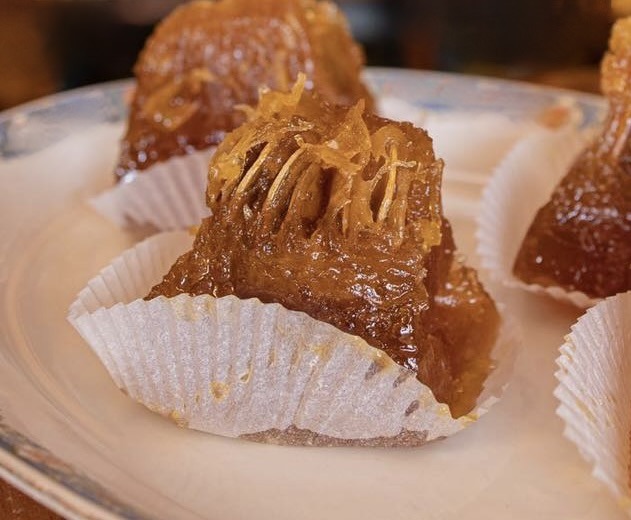
Tips for making the best dulce de chilacayote cristalizado (crystalized chilacayote candy)
- Make sure you choose a ripe and sweet chilacayote.
- Tap the chilacayote all around with a wooden spoon to loosen the skin. This will make it easier to remove the tough skin of the squash.
- When removing the skin, make sure you remove all of the green from the squash; your chilacayote should look completely white.
- When soaking in the lime solution, if you see the pieces of the top floating up make sure to turn them around every few hours and submerge them to ensure that all of the pieces of the chilacayote are fully soaked in the lime water.
- When the chilacayote is cooking, some pieces may float to the top; make sure you occasionally turn these so that all of the pieces cook thoroughly on all sides.
- You will know your chilacayote is crystalized when the fruit changes color and gets a glazed, shiny look to it. The reduced syrup should have also reached the thread stage. The cooked sugar in this stage forms a thin thread. The temperature range for the stage is 230–234 degrees Fahrenheit.
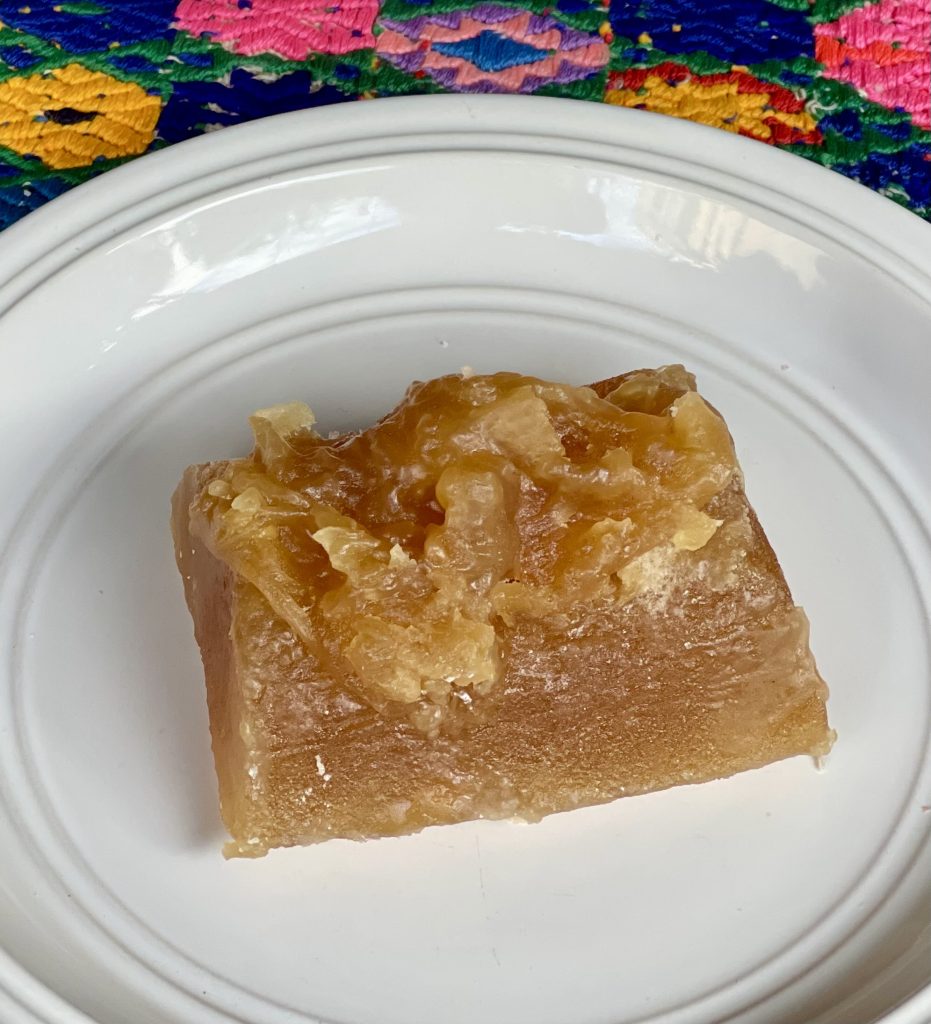
- When drying the chilacayote at the end of the process, it is best to dry it under the sun; this is the traditional method for making the crystalized chilacayote.
- Make sure that when you are drying the chilacayote all the pieces have some space in between so they don’t stick together.
- You can add different spices according to personal taste, such as cinnamon, cloves, and star anise, to give a unique flavor to the dessert.
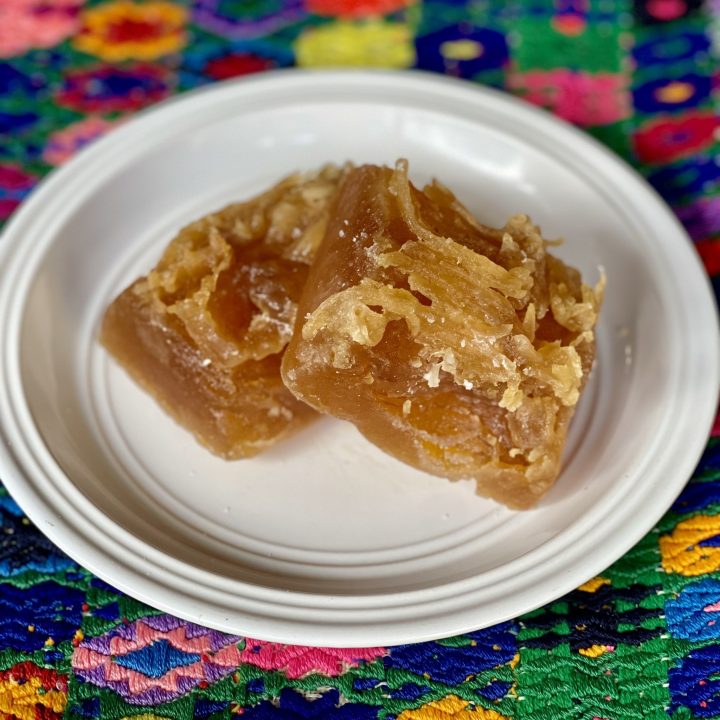
Guatemalan Dulce de Chilacayote Recipe (Crystalized Chilacayote Candy)
Ingredients
- 1 small chilacayote squash
- 1 cup slaked lime (food grade calcium hydroxide)
- 5 liters of water (for the lime solution)
- 7 lbs + 1/2 cup of sugar
- 14 liters of water for soaking, rinsing and cooking
- Cinnamon sticks, to taste
Instructions
Preparing the Chilacayote:
- Wash the chilacayote thoroughly and remove any dirt.
- Peel the chilacayote using a sharp knife.
- Cut the chilacayote into large cubes, about 3 inches by 3 inches.
Soaking the Chilacayote in Lime:
- Dissolve lime in 5 liters of water in a large container.
- Submerge the chilacayote cubes in the lime solution and let them soak for 24 hours.
- Rinse the chilacayote pieces with plenty of water the next day to remove lime residue.
- Make small holes in each chilacayote piece using a fork or toothpick.
Preparing the Syrup:
- Boil about 2 liters of water in a large pot.
- Cook the chilacayote in boiling water for 5 minutes, then remove and discard the water.
- Rinse the chilacayote again under running water.
- In the same pot, combine 5 liters of water, 3 lbs of sugar, and cinnamon sticks.
- Bring to a boil and simmer for 30 minutes until the sugar dissolves.
- Add the chilacayote cubes to the syrup and simmer for 1 hour.
- Let it stand for 24 hours.
- Repeat this process for five days, each time adding 1 lb of sugar to the syrup and simmering the chilacayote for 1 hour.
Final Steps:
- On the fifth day, simmer the chilacayote in the syrup for about 3 hours until crystallized.
- Remove the chilacayote from the syrup and drain on a rack.
- Let them dry for at least 8 hours.
- Boil 1 liter of water, add ½ cup of sugar, and bring to a boil.
- Dip each chilacayote piece in the boiling sugar water for a few seconds, then place on a drying rack.
- Sprinkle each piece with powdered sugar using a strainer, ensuring all sides are covered in a thin layer of powdered sugar.
- Let them dry for an additional 8 to 10 hours.
Notes
If you need more water, consider that the ratio of lime to water should be ¼ cup of lime per liter of water.
Other Guatemalan Candy Recipes
Canillitas De Leche
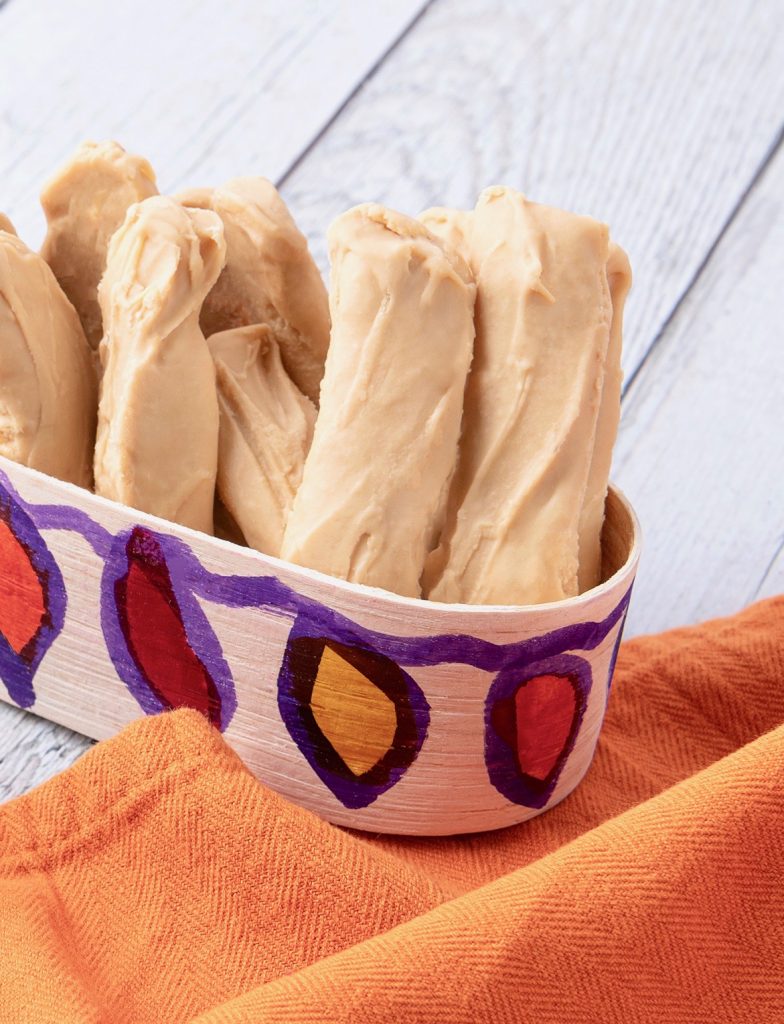
Guatemalan Naranjas En Miel Recipe (Candied Oranges Recipe)
This dessert, made with oranges and honey, offers a distinct blend of flavors, combining the sweetness of sugar-infused honey with the slightly bitter and citrusy taste of oranges. It can be enjoyed as a delightful treat on its own, a topping for desserts, or as a sweet addition to various dishes. This simple recipe for Guatemalan candied oranges, known as “naranjas en miel,” requires only two ingredients and is both delicious and easy to make.
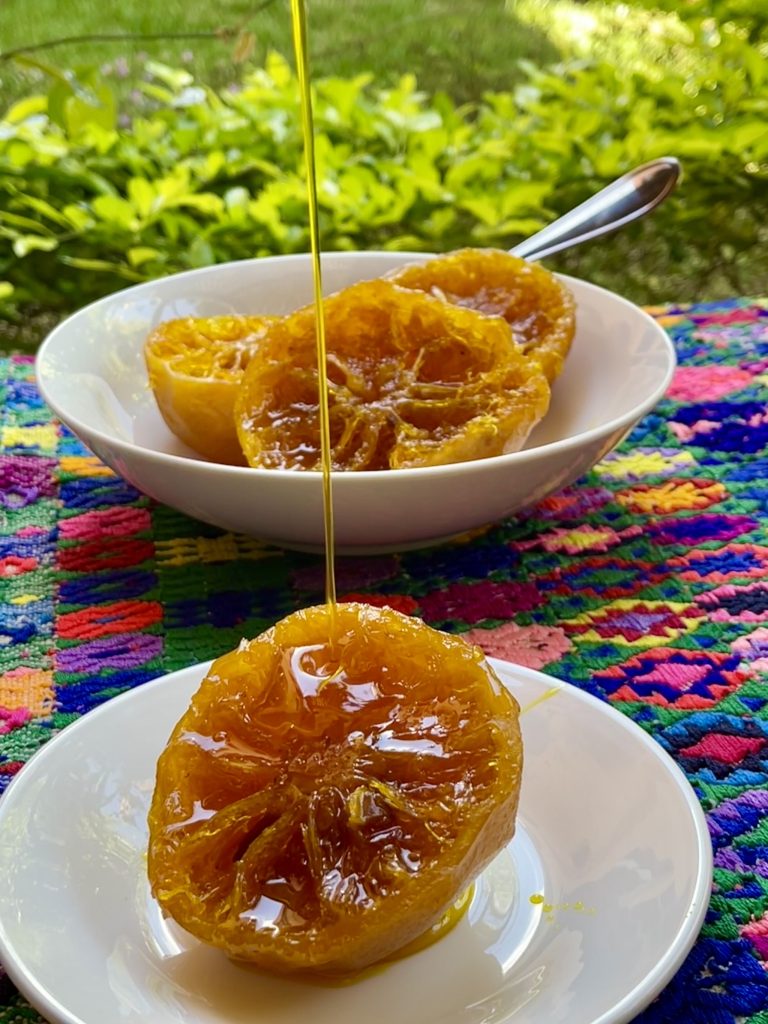
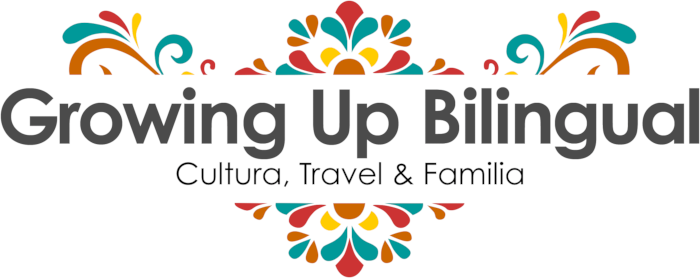
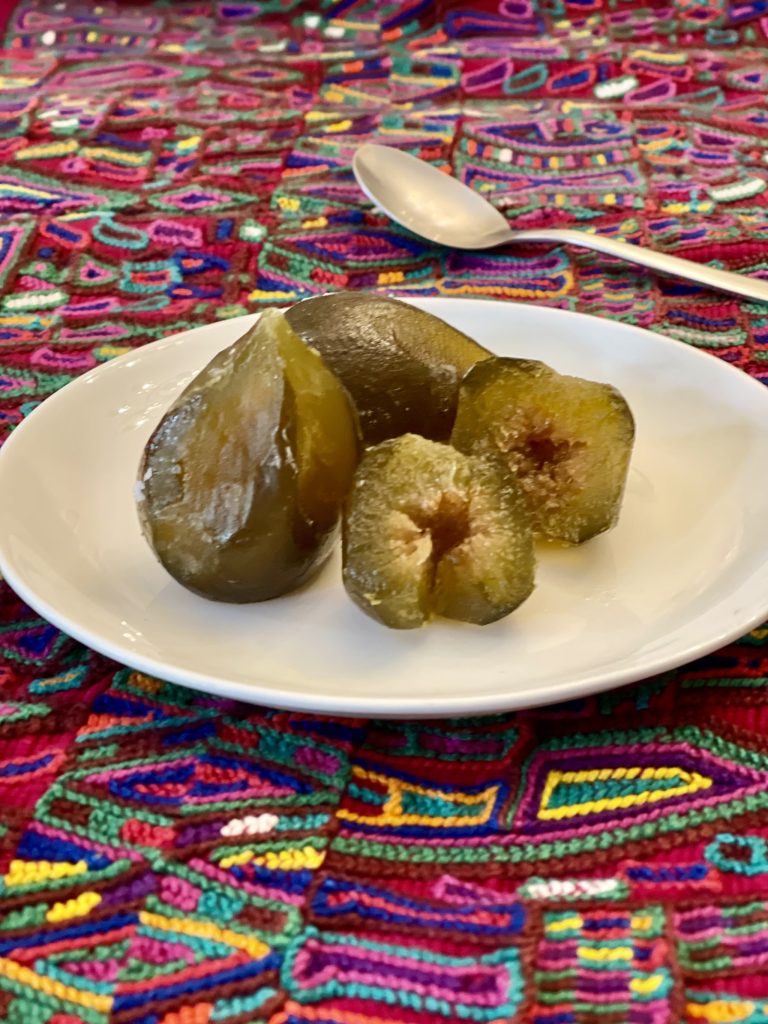
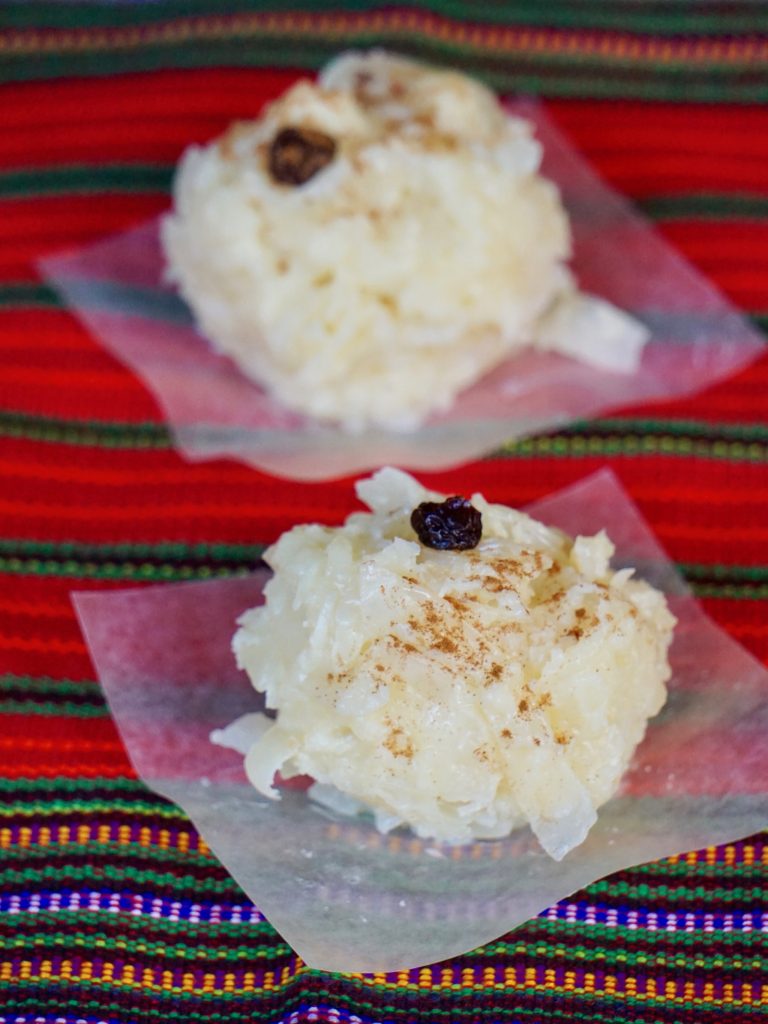 Cocadas reales, Guatemalan traditional candy.
Cocadas reales, Guatemalan traditional candy.
